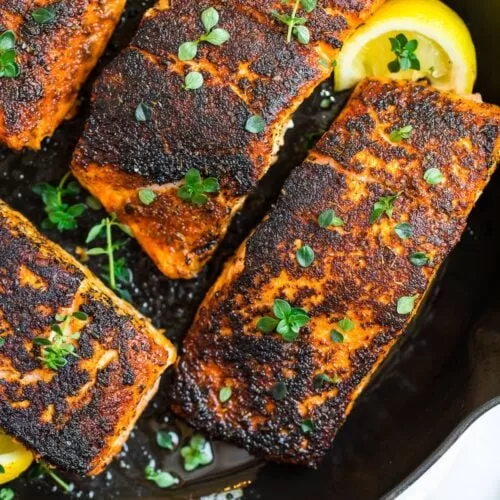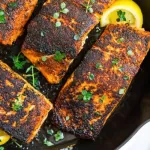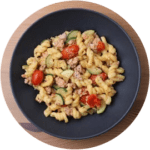How to cook the BEST Blackened Salmon. Fillets are brushed with butter, rubbed with a bold spice blend, and pan-seared to perfection.
Blackening is a method of cooking suitable for firm-bodied fish and is also commonly used for chicken. To achieve the desired blackened effect, the fillets are brushed with butter (specifically butter for it to darken) and then generously coated with a mixture of herbs and spices known as “blackening seasoning.”
The blackened salmon is not cooked to the point of being burnt. Instead, the rich color is achieved through the butter’s milk solids being toasted to a deep golden hue, and the spices being slightly charred when the fish is cooked on a hot pan. This results in a burst of flavourful taste.
I hold dear the instance when my fork pierces through the layer of blackening seasoning and uncovers the vibrant pink and tender flakes of salmon beneath.
Salmon is a frequent choice for our meals at home due to its widespread availability, nutritional benefits, and versatility in cooking methods and flavour options.
FAQS & TIPS
What are the health benefits of blackened salmon?
The American Heart Association recommends eating fish twice a week due to its heart healthy benefits. Specifically, salmon is high in omega 3 fatty acids, which have anti-inflammatory properties. It is also a great source of protein, iron, and vitamins A and D.
Where did blackened fish originate?
The blackening technique is said to have originated in the 19th century in the French Quarter of New Orleans, where cooks would sear meat or fish in a hot cast iron skillet until it developed a charred, spicy crust.
Can you eat the black skin on salmon?
Yes, salmon skin is good for you—and is actually one of the healthiest parts of the fish. Just like the flesh, salmon skin is a good source of omega-3 fatty acids, vitamins B and D, and minerals like niacin and phosphorus.
Blackened Salmon
Ingredients
- 4 6- ounce salmon fillet portions skin-on
- 1 tablespoon paprika
- 1/2 teaspoon Cajun seasoning
- 1 teaspoon sea salt
- 1/2 teaspoon ground pepper
- 3/4 teaspoon garlic minced
- 1/2 teaspoon dried thyme
- 1/2 teaspoon dried oregano
- 2 tablespoons unsalted butter
- Chopped fresh parsley
- 1 lemon cut into wedges
Instructions
- Place the salmon on a large plate, flesh-side up, and pat dry.
- In a small bowl, stir together the paprika, cajun seasoning, sea salt, ground pepper, parsley, garlic, thyme and oregano.
- Put butter in a separate small bowl and melt the butter.
- Brush the butter over the flesh-side of the salmon fillets, then sprinkle the flesh sides evenly with the spice mixture. Lightly pat the spices to adhere as needed.
- Heat a large cast iron skillet over medium-high heat. Once the pan is completely hot add the salmon fillets flesh-side down. Cook for 2 to 3 minutes without disturbing the fillets, then carefully turn each piece of salmon over.
- Continue cooking over medium heat, until the skin becomes crispy, and the fish is fully cooked through, about 5 to 6 additional minutes depending upon the thickness of your fillets. The fish should reach 145 degrees F on an instant read thermometer and flake easily with a fork at its thickest part.
- Squeeze lemon over the salmon, then transfer the fillets to serving plates. Serve immediately with a sprinkle of fresh thyme and additional lemon wedges.
If we missed any questions that you may have, feel free to leave your questions in the comment section below.




